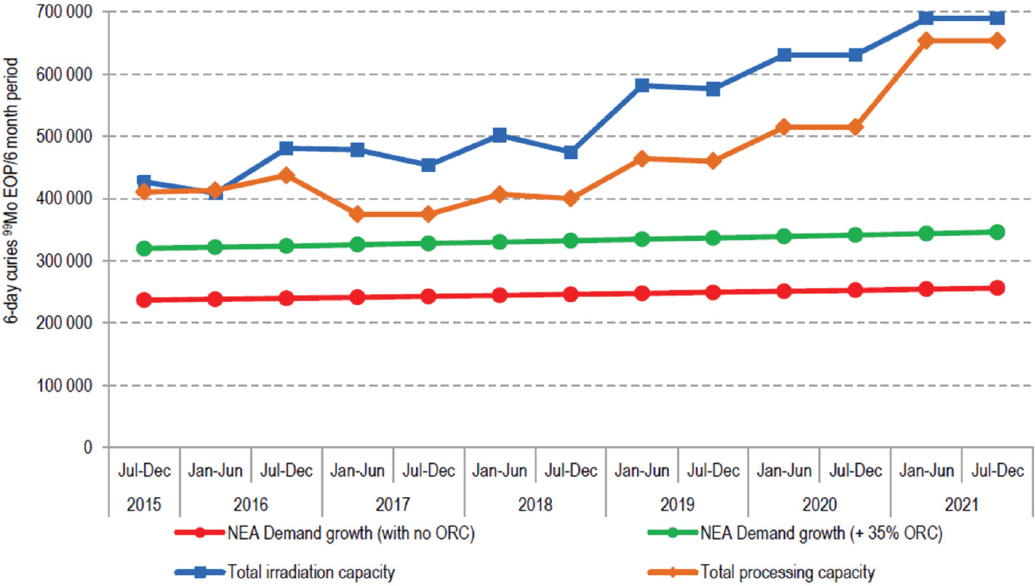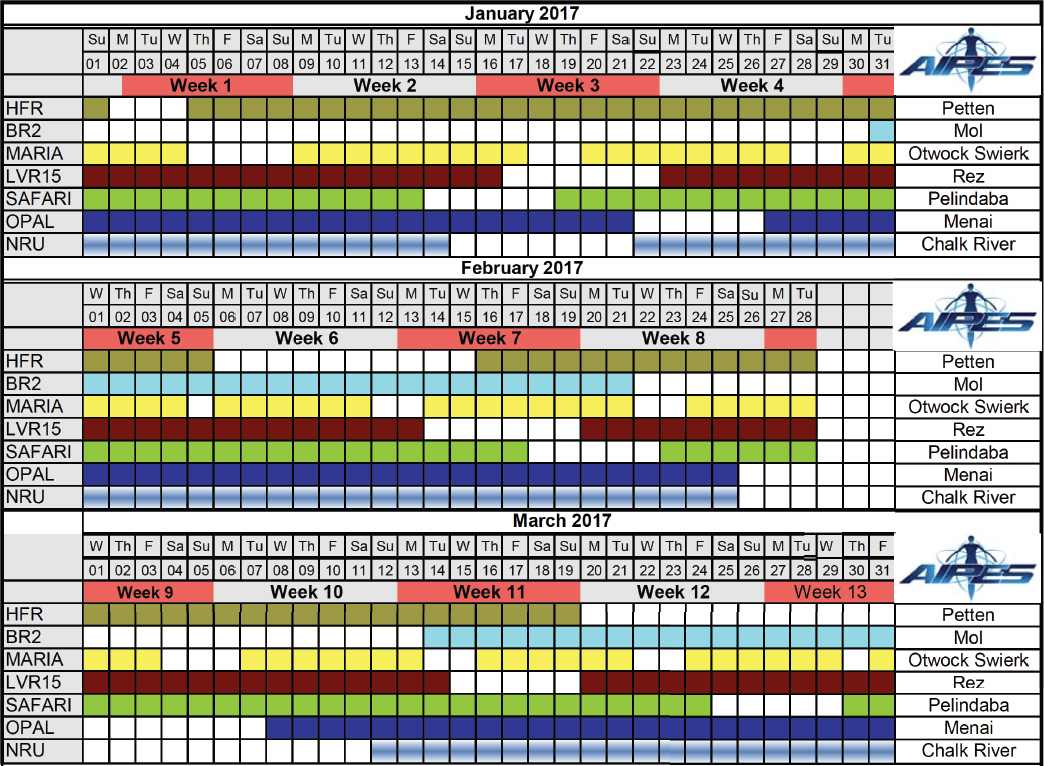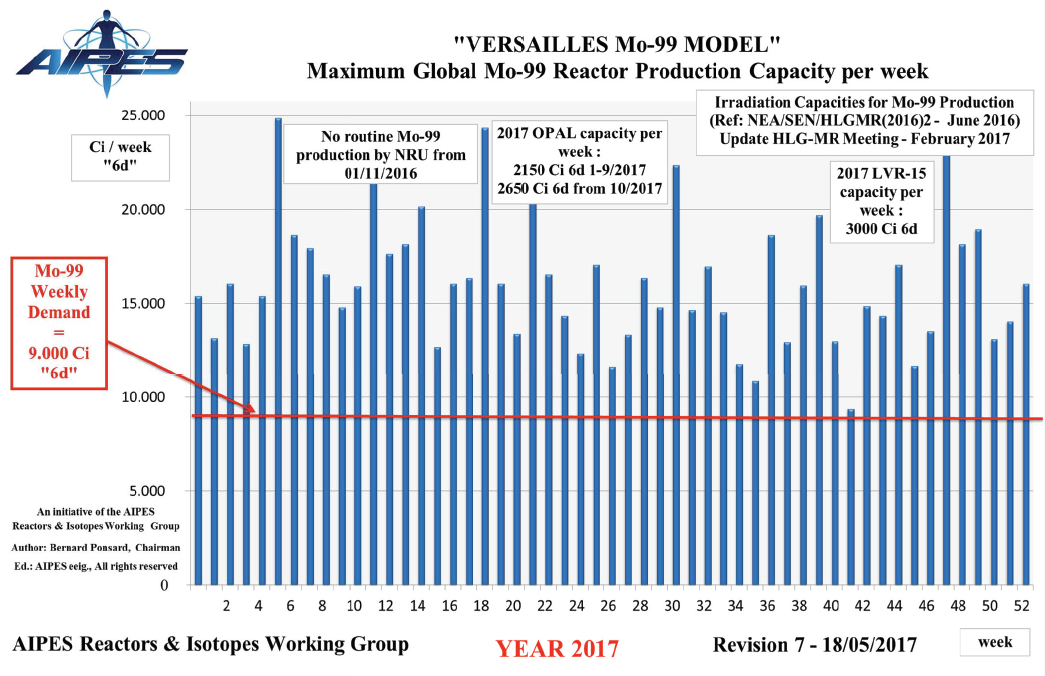5
Supply Reliability
The 2009-2010 molybdenum-99 (Mo-99) supply shortages that occurred when Canada’s NRU and Europe’s HFR reactors were simultaneously shut down for extended periods exposed the vulnerabilities of the Mo-99 supply. Vulnerabilities included the aging and not-well-maintained reactor infrastructure, less than optimum coordination of reactor operating and maintenance schedules, and lack of options for increasing production from operating reactors during shortages. Since the 2009-2010 shortages, governments and industry have taken several actions to improve the reliability of the Mo-99/Tc-99m supply chain. These actions include increasing production capacity and outage reserve capacity; monitoring and reviewing of the supply chain to identify periods of potential risk; investing in the durability of the supply; coordinating reactor schedules; enhancing communications among supply chain participants; and developing backup agreements between producers and irradiators. Many symposium participants including Mr. Roy Brown (Curium), Mr. Jean-Michel Vanderhofstadt (IRE), and Dr. Kathrine Smith (Australian Embassy and Permanent Mission to the International Atomic Energy Agency in Vienna) noted that the supply market is more reliable today because of all these actions.
Dr. Kennedy Mang’era (Canadian Isotope Innovations Corp. [CIIC]) disagreed that the existing supply chain has reached a satisfactory level of reliability. He pointed out that an unexpected simultaneous shutdown of two reactors with high Mo-99 production capacity (for example the BR-2 and HFR reactors in Europe) could still lead to severe supply shortages.1 Dr. Smith and others responded to the comment by stating that the likelihood of the scenario of two reactors shutting down unexpectedly and simultaneously is low because of actions taken by governments and industry to prevent that scenario from happening. In addition, if this scenario were to occur, the enhanced communication channels that are in place today can mitigate the consequences of reactor shutdowns and prevent supply disruptions.
___________________
1 In November 2017, Mo-99 production at NTP was halted “because of non-compliance with licensing conditions.” See http://m.engineeringnews.co.za/article/south-african-nuclear-body-shuts-down-key-unit-because-of-compliance-failure-2017-11-22; https://www.reuters.com/article/us-safrica-isotopes/south-african-mo-99-plant-shut-after-suspected-hydrogen-leak-idUSKBN1DM2GS?feedType=RSS&feedName=environmentNews. The shutdown lasted for more than 7 weeks and production had not restarted at the time this proceedings was at the final publication stage. AIPES anticipated that NTP’s temporary shutdown would cause Mo-99 shortages in selected markets (see https://www.bnms.org.uk/radioisotope-supplies/molybdenum-supplies/). The situation was constrained due to the scheduled refueling of the OPAL reactor.
INCREASING PRODUCTION CAPACITY AND OUTAGE RESERVE CAPACITY
As noted in Chapter 3, current Mo-99 producers have made significant investments to increase Mo-99 production capacity. Mr. Roy Brown and Mr. Gavin Ball noted that Curium and NTP have also increased paid outage reserve capacity. Other existing producers also may have increased the paid outage reserve capacity, but did not comment on that at the symposium.
MONITORING AND REVIEWING OF THE SUPPLY CHAIN
The Organisation for Economic Co-operation and Development’s Nuclear Energy Agency (OECD-NEA) released its first report on Mo-99 supply and demand forecast in 2012 (OECD-NEA, 2012a) and updates in 2014 (OECD-NEA, 2014a), 2015 (OECD-NEA, 2015b), 2016 (OECD-NEA, 2016), and more recently in 2017 (OECD-NEA, 2017). Dr. Smith presented the major findings of the 2017 OECD-NEA update, which provides supply projections up to 2022.
Existing supply chain participants have maintained supply during the period examined in the report with only minor disruptions. OECD-NEA projects that contribution of Mo-99 supply from alternative technologies starting in 2018 is expected to be substantial. However, since the 2016 OECD-NEA update, many prospective processing projects have been delayed, and further delays can be expected (see Figure 5.1). If no additional capacity is added from alternative technologies by mid-2018 (when the NRU reactor in Canada permanently shuts down), the level of capability to manage potential supply disruptions will be reduced. Overall, the OECD-NEA report concluded that the supply situation will require careful and well-considered planning to minimize risks and that regular monitoring and review are needed on progress toward bringing new capacity to market.

NOTE: This scenario, referred to as Scenario C or Project Delayed Scenario in the OECD-NEA (2017) report, builds on the technological challenge scenario and assumes that the qualified projects that aim to produce Mo-99 are delayed by 1 year.
INVESTING IN DURABILITY OF THE SUPPLY CHAIN
Two examples of investments in the durability of the supply chain were discussed at the symposium: in target manufacturing by CERCA and in reactor operations by the Belgian Nuclear Research Center (SCK•CEN), the operator of the BR-2 reactor.
CERCA
The 2016 National Academies report raised a concern about the vulnerability of the front end of the supply chain because one company, CERCA, provides the majority of the targets used to produce Mo-99. CERCA representatives Mr. Yann Guinard and Mr. Bertrand Stepnik estimated that since the 1970s, CERCA has manufactured more than 200,000 HEU plates, and since 2008 more than 50,000 LEU plates.
Mr. Guinard discussed the company’s investment to “ensure CERCA’s long-term presence as the reference supplier” of Mo-99 targets. These investments involved
- Changes in the plant environment,
- Upgrades in the existing plant to comply with applicable safety and security requirements, and
- Construction of a new building to host uranium alloy fabrication activities (to be commissioned in 2021).
CERCA is part of AREVA-NP, a subsidiary of AREVA SA, a private company that is fully owned by the French government. In the framework of the reorganization of the AREVA Group, AREVA NP will become an affiliate of Électricité de France (EDF), the French electricity utility company, under the temporary name “New NP.” Mr. Guinard said that the reorganization will provide to CERCA a “sustainable financial structure.”
SCK•CEN
Mr. Bernard Ponsard (SCK•CEN) noted that BR-2’s 18-month maintenance and modernization operation, which ended in July 2016, aimed to improve the reactor’s safe and efficient operations. Various systems and components were replaced as a precaution and, as a result, it is possible that the reactor’s operating license can be extended by 10 years, that is, to 2036.
COORDINATING REACTOR SCHEDULES
Mr. Bernard Ponsard represented the Association of Imaging Producers and Equipment Suppliers’ (AIPES’) Security of Supply Working Group2 and presented on the group’s role in supply reliability and current activities. The group is tasked with coordinating the international scheduling of reactors that produce Mo-99 to provide global coverage during reactor shutdown periods. Participation in the scheduling efforts is at the discretion of the producer and relies upon willingness to contribute schedule information.
Initially, AIPES concentrated on European research reactors, but following the severe disruptions of Mo-99 supply in 2009-2010, the group incorporated all research reactors that supply the global market in its scheduling efforts. Today BR-2 (Belgium), HFR (Netherlands), Maria (Poland), LVR-15 (Czech Republic), SAFARI-I (South Africa), OPAL (Australia), RA-3 (Argentina), and FRM-II (Germany) contribute reactor schedules (see Figure 5.2). Ira Goldman (Lantheus), who is the current chairman of the Security of Supply Working Group, noted that AIPES has engaged the Russian State Atomic Energy Corporation, Rosatom, in many discussions about the possibility of the Russian reactors contributing schedule information to AIPES to benefit the reliability of the supply chain, but Rosatom has not agreed to do so. Mr. Alexey Vakulenko (JSC Isotope) responded to the comment by stating that Russia’s reactor schedule contribution would not be relevant at this point because Mo-99 produced in Russia has not received drug regulatory approvals to be marketed in the European, U.S., and other markets. Therefore, it
___________________
2 Previously known as Reactors and Isotopes Working Group.

SOURCE: Bernard Ponsard, SCK•CEN.
could not be used to mitigate potential global Mo-99 supply shortages. However, he welcomed continuing discussions between Rosatom and AIPES on the topic, especially as Russia increases its Mo-99 global market share.
AIPES has developed the AIPES Mo-99 capacity model3 an analytical tool to improve reactor operation scheduling and to assess the impacts of schedules on global Mo-99 production. The model was developed in 2014 and is monitoring the maximum reactor capacity available per week for the global production of Mo-99 (see Figure 5.3). Mr. Ponsard noted that it is a suitable tool to assist in scheduling the reactor operating periods with respect to optimal Mo-99 production and supply and to identify periods at risk that need to be further investigated at the processor and generator manufacturer level.
AIPES has taken additional actions to improve Mo-99 production monitoring and stakeholder communication. In 2012, it created the Emergency Response Team to follow production and supply issues week by week through conference calls, if requested. This continuing follow-up allows AIPES to identify the potential for Mo-99 shortages and to define action plans with research reactors, processors, and generator manufacturers. The AIPES Emergency Response Team—currently chaired by Mr. Ponsard—is also concerned with the security of supply of other medical radiosotopes, for example Lu-177.
___________________
3 Previously known as the Versailles model.

SOURCE: Bernard Ponsard, SCK•CEN.
CREATING BACKUP AGREEMENTS
Irradiating facilities and producers have business agreements in place for backup production and supply of Mo-99. These backup agreements aim to prevent or reduce the effects of scheduled and/or unscheduled shutdowns of production facilities with the ultimate goal to prevent the potential for Mo-99 supply shortages. Three such backup agreements were mentioned at the symposium:
- Between BR-2 and HFR,
- Between OPAL and SAFARI-I, and
- Among all four global producers.
The details of the backup agreements were not discussed at the symposium.
This page intentionally left blank.






